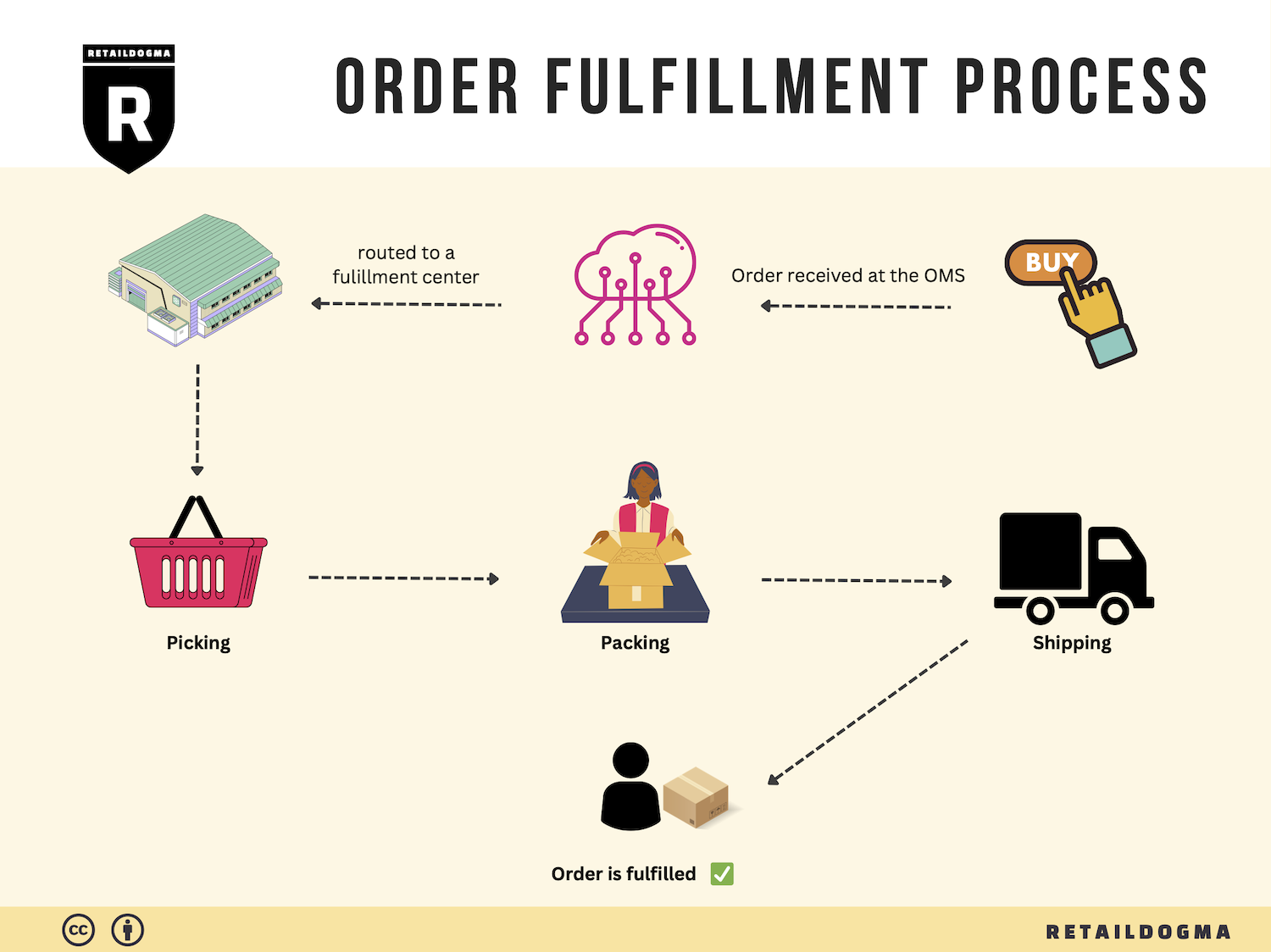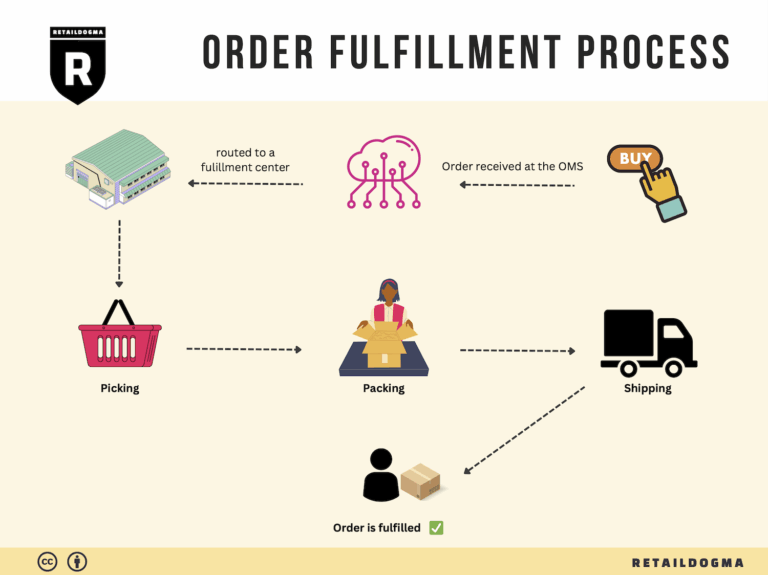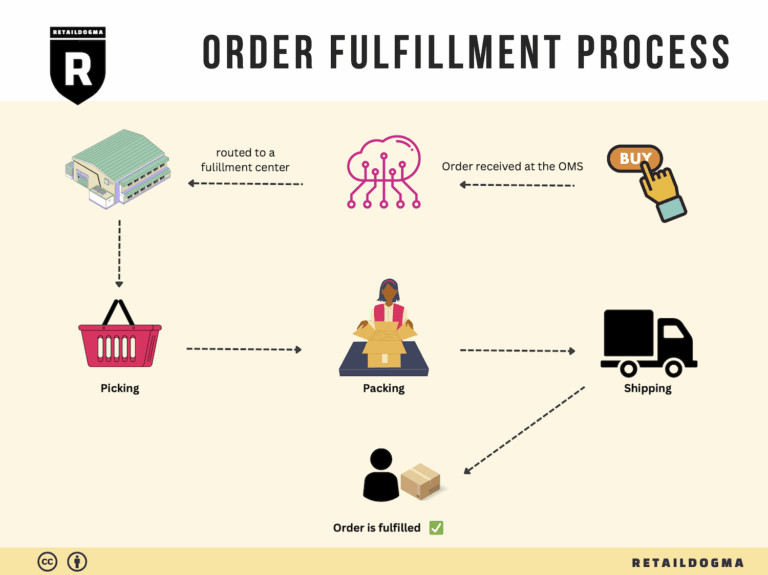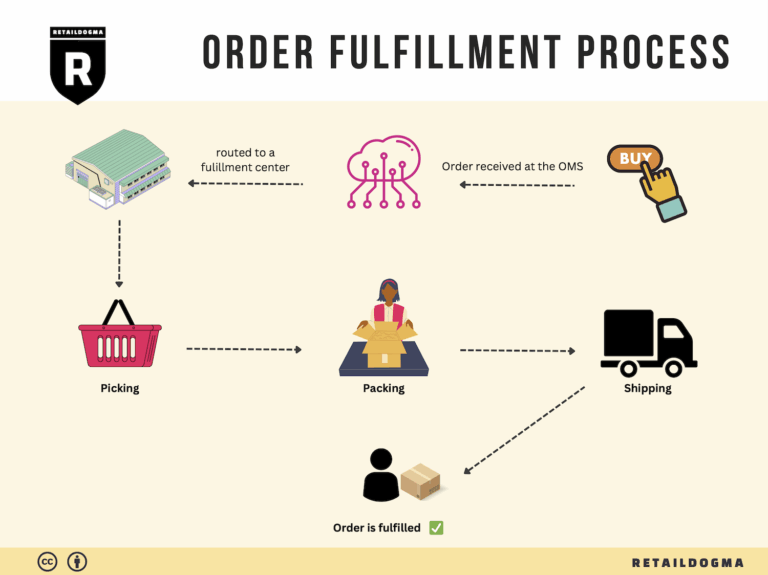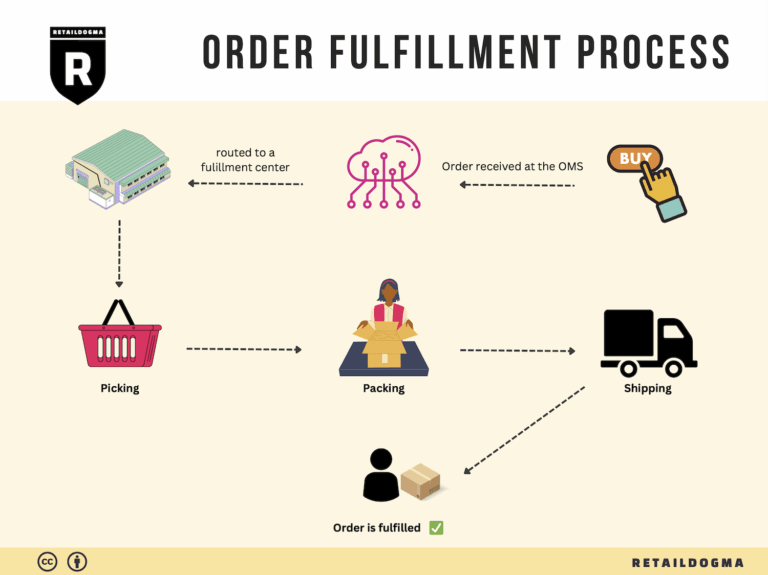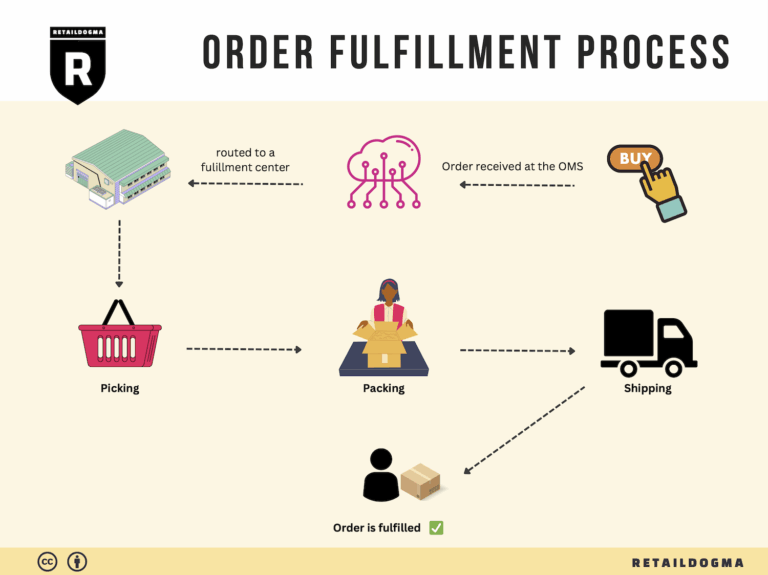Ecommerce Fulfillment Services: The Ultimate Guide (2025)
What is E-commerce Fulfillment? An Introduction for Growing Businesses
Understanding the Challenges of Order Fulfillment
As an e-commerce business owner, you likely know the thrill of making a sale. However, that excitement can quickly turn into stress when it comes time to pack and ship orders. Many growing businesses find themselves overwhelmed by the logistics of fulfillment, leading to errors, delays, and ultimately, dissatisfied customers. This is where e-commerce fulfillment comes into play, serving as a crucial lifeline for your operations.
What is E-commerce Fulfillment?
In simple terms, e-commerce fulfillment refers to the entire process of getting a product from your inventory to the customer’s doorstep. This includes receiving, storing, picking, packing, and shipping the items ordered online. As your business scales, the complexities of this process can increase significantly, making it essential to have a solid fulfillment strategy in place.
What This Guide Will Cover
In this comprehensive guide, we will explore various facets of e-commerce fulfillment tailored specifically for growing businesses. We will examine different fulfillment models, such as Third-Party Logistics (3PL) and Fulfillment by Amazon (FBA), helping you understand the options available to you.
You will learn about the core services that fulfillment companies typically offer, including warehousing, inventory management, order processing, and returns management. Understanding these services is key to ensuring a seamless customer experience.
Additionally, we will provide you with practical advice on how to choose the right fulfillment partner. Factors such as scalability, pricing, customer service, and technological integration are crucial considerations that can impact your business’s growth trajectory.
Pricing Insights
Fulfillment costs can vary widely depending on the services you choose and the volume of your orders. This guide will help you navigate pricing structures, including hidden fees and potential savings, allowing you to make informed financial decisions.
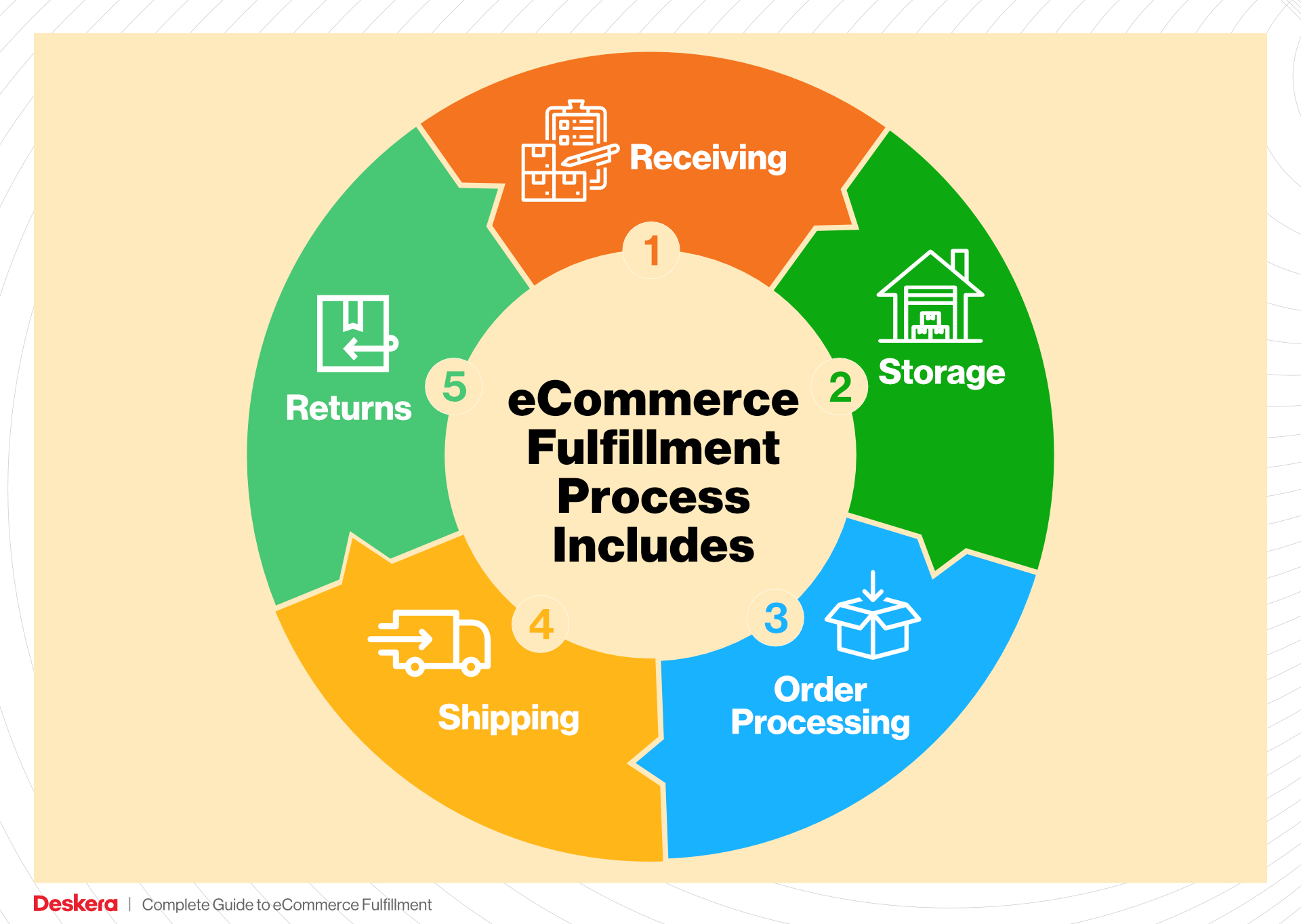
Empowering Smart Decisions
Our goal with this guide is to empower you with the knowledge and tools necessary to make smart decisions about your logistics. By understanding the ins and outs of e-commerce fulfillment, you can focus on what matters most—growing your business and delighting your customers. Whether you’re a startup or an established brand looking to optimize your operations, this guide will serve as a valuable resource in your journey toward efficient and effective fulfillment.
What You’ll Learn In This Guide
- What is E-commerce Fulfillment? An Introduction for Growing Businesses
- The Order Fulfillment Process: From ‘Buy’ Button to Customer’s Door
- Comparing Fulfillment Models: In-House vs. 3PL vs. Dropshipping
- A Deep Dive into Amazon FBA: Pros, Cons, and Who It’s For
- Core Services Offered by Fulfillment Centers
- How to Choose a Fulfillment Partner: A 6-Point Checklist
- Understanding Fulfillment Pricing: A Breakdown of Common Fees
- Frequently Asked Questions (FAQs) about Fulfillment
- Conclusion: Is Outsourcing Fulfillment the Right Move for Your Business?
- Important Disclaimer
The Order Fulfillment Process: From ‘Buy’ Button to Customer’s Door
1. Receiving Inventory
The order fulfillment process begins with receiving inventory, a crucial step that sets the stage for efficient operations. When products arrive at the fulfillment center, they must be carefully checked against purchase orders to ensure accuracy. This involves verifying the quantity and condition of items, often facilitated by a key term known as SKU (Stock Keeping Unit), which uniquely identifies each product.
Receiving inventory is important because it establishes the accuracy of stock levels and prevents discrepancies that can lead to stockouts or overstock situations. Effective inventory management starts with this step; any errors here can ripple through the entire fulfillment process, resulting in delayed shipments and unsatisfied customers. To streamline this step, businesses should invest in technology that allows for real-time tracking of incoming goods, ensuring that every item is accounted for and stored correctly.
2. Warehouse Storage
Once inventory is received, the next phase is warehouse storage. This step involves organizing products in a way that maximizes space and facilitates easy access. Efficient warehouse layout and inventory management systems play a critical role here. Using techniques such as ABC analysis, where items are categorized based on their turnover rates, can significantly enhance storage efficiency.
Warehouse storage is vital because it directly impacts the speed and accuracy of order fulfillment. A well-organized warehouse reduces the time spent locating products, which is essential for meeting customer expectations, especially during peak seasons. Additionally, businesses can implement automated inventory management solutions that provide real-time updates on stock levels, allowing for better planning and forecasting.
3. Order Picking
The order picking process follows storage and is where items are retrieved based on customer orders. This step typically utilizes pick lists, which detail the items and quantities needed for each order. Warehouse staff or automated systems use these lists to locate and gather products efficiently.

Order picking is a critical component of fulfillment as it directly affects order accuracy and speed. Errors during picking can lead to wrong shipments, which not only frustrates customers but can also result in costly returns. To optimize this process, businesses can employ strategies like batch picking (picking multiple orders simultaneously) or zone picking (assigning specific areas of the warehouse to individual pickers). Implementing technology such as barcode scanning can further enhance accuracy and efficiency, reducing human error and increasing productivity.
4. Order Packing
After picking, the next step is order packing. This involves carefully packing the items to protect them during transit while also ensuring they represent the brand effectively. Key elements in this step include choosing the right packaging materials and creating a packing slip, which details the contents of the package and serves as a receipt for the customer.
Order packing is essential for maintaining product integrity and enhancing the customer experience. Properly packed items are less likely to be damaged during shipping, reducing return rates and increasing customer satisfaction. Additionally, businesses can create memorable unboxing experiences by using branded packaging materials, which can foster brand loyalty. To optimize packing efficiency, companies can utilize automated packing stations that help streamline the process and reduce labor costs.
5. Shipping & Delivery
The final step in the order fulfillment process is shipping and delivery. This phase involves selecting the appropriate shipping method based on factors such as cost, speed, and destination. Businesses often work with multiple carriers and utilize a shipping network to ensure timely deliveries. Tracking systems are also implemented to provide real-time updates to customers about their order status.
Shipping and delivery are crucial as they are the last touchpoints between the business and the customer. The speed and reliability of this step can significantly influence customer satisfaction and retention. To enhance the shipping process, companies should consider offering multiple shipping options, including express services for urgent orders. Additionally, leveraging data analytics can help businesses optimize shipping routes and reduce costs, ultimately improving their overall fulfillment strategy.
In conclusion, understanding and optimizing each step of the order fulfillment process—from receiving inventory to shipping and delivery—can significantly enhance operational efficiency and customer satisfaction. By implementing best practices and leveraging technology, e-commerce businesses can scale their operations effectively while maintaining a high level of service.
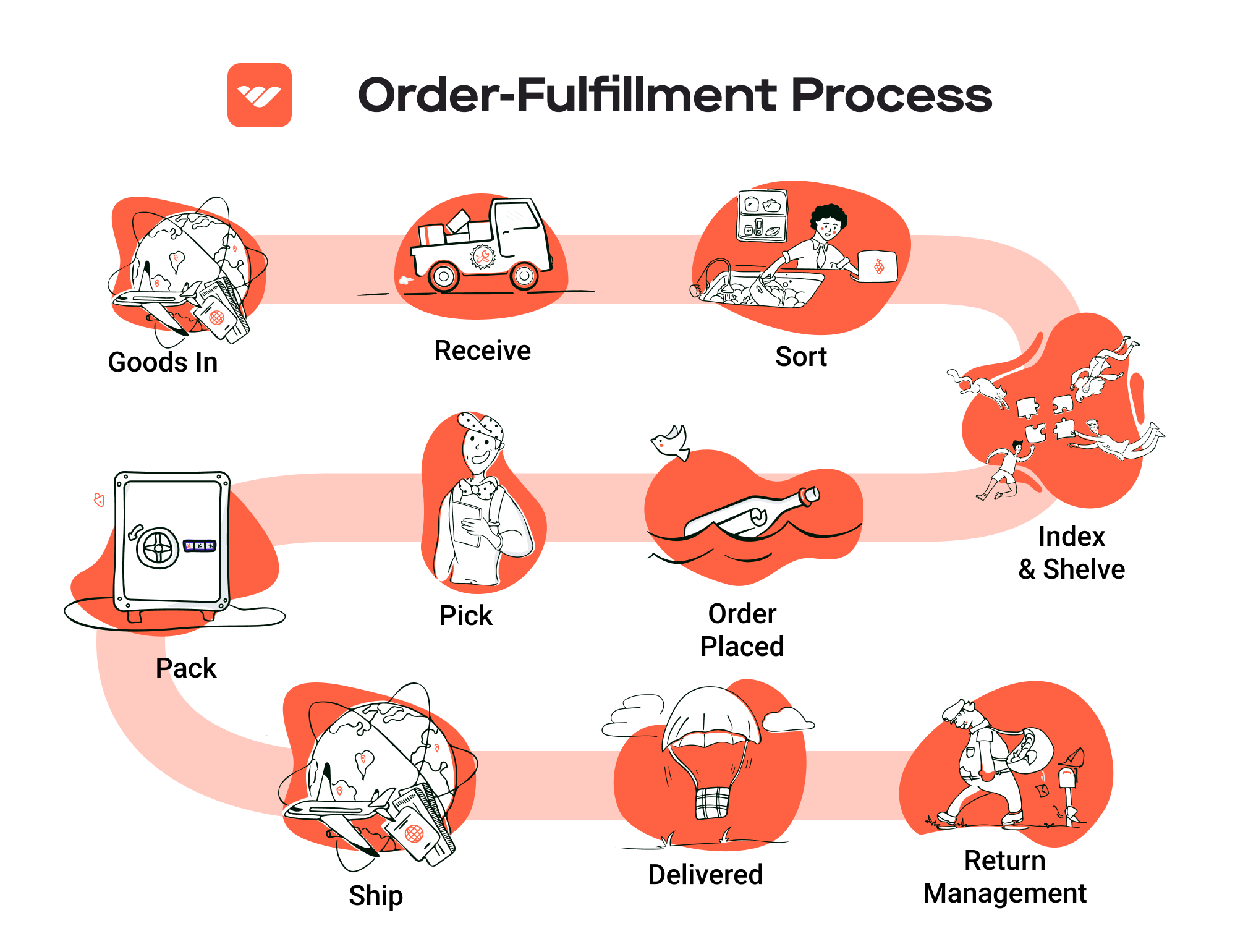
Comparing Fulfillment Models: In-House vs. 3PL vs. Dropshipping
Fulfillment Model Comparison
| Model | Who Handles Inventory | Best For (Business Stage) | Key Advantage | Key Disadvantage |
|---|---|---|---|---|
| In-House Fulfillment | The e-commerce business owner | Startups to Established | Complete control over operations | High overhead and fixed costs |
| Third-Party Logistics (3PL) | Third-party fulfillment provider | Growth-focused businesses | Scalability and expertise | Less control over inventory |
| Dropshipping | Supplier or manufacturer | Startups and niche markets | Low startup costs and risk | Lower profit margins and quality control issues |
In-House Fulfillment
In-house fulfillment involves managing inventory and order processing directly within your business. This model is often favored by startups that want complete control over their operations, branding, and customer experience. With in-house fulfillment, businesses can customize packaging and shipping processes to align with their brand image, ensuring that every customer interaction reflects their values. Additionally, having direct oversight allows for rapid adjustments to inventory levels and fulfillment processes based on real-time demand.
However, while in-house fulfillment offers significant control, it also comes with substantial overhead costs. Businesses must invest in warehousing, technology, staffing, and logistics, which can strain resources, especially for startups or small businesses. Furthermore, as order volumes grow, the complexity of operations can increase, leading to potential inefficiencies. This model is best suited for businesses that have established demand and resources to invest in logistics infrastructure.
Third-Party Logistics (3PL)
Third-party logistics (3PL) providers offer a comprehensive solution for businesses looking to outsource their fulfillment processes. These companies specialize in handling warehousing, inventory management, order processing, and shipping, allowing e-commerce businesses to focus on core activities like marketing and product development. 3PL providers are particularly beneficial for businesses in a growth phase, as they can scale operations rapidly without the need for significant capital investment in infrastructure.
One of the key advantages of using a 3PL is the expertise and technology they bring to the table. Most 3PLs have established relationships with shipping carriers, allowing businesses to benefit from lower shipping costs and faster delivery times. They also often provide advanced inventory management systems that integrate seamlessly with e-commerce platforms, enabling real-time tracking and reporting. However, the trade-off is that businesses relinquish some control over inventory management and fulfillment processes. This can lead to challenges in maintaining brand consistency and ensuring customer satisfaction if the 3PL does not meet expectations.
Dropshipping
Dropshipping is a fulfillment model where the e-commerce retailer does not hold inventory. Instead, when a customer places an order, the retailer purchases the item from a third-party supplier who ships it directly to the customer. This model is particularly appealing to startups and niche markets because it requires minimal upfront investment and eliminates the risks associated with holding inventory.
The primary advantage of dropshipping is its low barrier to entry. Entrepreneurs can start an e-commerce business without the need for significant capital investment in inventory or warehousing. Additionally, it allows for a wide range of products to be offered without the risk of unsold stock. However, dropshipping also has notable disadvantages. Profit margins can be thin due to the costs associated with purchasing from suppliers, and businesses often face challenges in quality control and delivery times. Since the retailer relies on the supplier for fulfillment, any delays or product issues can directly impact customer satisfaction and brand reputation.
Conclusion
Choosing the right fulfillment model is crucial for e-commerce businesses looking to scale efficiently. In-house fulfillment offers control but comes with higher costs and complexity. Third-party logistics provide scalability and expertise, making them ideal for growth-focused businesses. Dropshipping offers a low-risk entry point for new entrepreneurs but may lead to challenges in quality and profit margins. Understanding the nuances of each model will help e-commerce owners make informed decisions that align with their business goals and customer expectations.
A Deep Dive into Amazon FBA: Pros, Cons, and Who It’s For
Understanding Fulfillment by Amazon (FBA)
Fulfillment by Amazon (FBA) is a service offered by Amazon that allows e-commerce sellers to store their products in Amazon’s fulfillment centers. With FBA, Amazon takes care of storage, packaging, shipping, and customer service for the products sold through the Amazon marketplace. This service is designed to simplify the logistics and fulfillment process for sellers, enabling them to focus on growing their businesses while leveraging Amazon’s vast distribution network.
How FBA Works
-
Setting Up an Account: Sellers need to create an Amazon Seller account and enroll in the FBA program. This process includes listing products and determining shipping plans for inventory.
-
Shipping Inventory: Once enrolled, sellers send their products to Amazon’s designated fulfillment centers. Sellers can choose to ship products to one or multiple warehouses based on Amazon’s recommendations.
-
Storage and Management: Amazon stores the inventory in their fulfillment centers. Sellers can manage their inventory through the Amazon Seller Central dashboard, where they can track stock levels and manage orders.
-
Order Fulfillment: When a customer orders a product, Amazon picks, packs, and ships the item on behalf of the seller. This includes managing all aspects of shipping, including tracking and customer notifications.
-
Customer Service and Returns: Amazon also handles customer service inquiries and returns for FBA products, ensuring that customers receive a consistent and reliable service.
Pros of Fulfillment by Amazon (FBA)
-
Prime Eligibility: One of the most significant advantages of FBA is that products become eligible for Amazon Prime. This means that Prime members can receive their orders with free two-day shipping, which can significantly increase sales and visibility.
-
Customer Trust: Amazon is a recognized and trusted brand. By using FBA, sellers can leverage Amazon’s reputation, which can lead to higher conversion rates. Customers are often more likely to purchase items that are fulfilled by Amazon due to the assurance of reliable service.
-
Multi-Channel Fulfillment: FBA allows sellers to fulfill orders not only from Amazon but also from their own websites and other marketplaces. This flexibility can streamline operations and improve inventory management across multiple sales channels.
-
Scalability: FBA provides a scalable solution for businesses looking to grow. Sellers can increase their product offerings without worrying about the logistics of storage and shipping, allowing them to focus on marketing and sales strategies.
-
Comprehensive Customer Service: Amazon handles customer inquiries and returns, which can free up valuable time for sellers. This support can be particularly beneficial for small businesses that may not have the resources to manage customer service effectively.
Cons of Fulfillment by Amazon (FBA)
-
High Fees: While FBA offers many benefits, the costs can add up. Sellers incur storage fees for their inventory, as well as fulfillment fees for each item sold. These fees can be higher than those charged by traditional fulfillment services, especially for slow-moving products.
-
Strict Inventory Rules: Amazon has stringent inventory management policies. Sellers must adhere to guidelines regarding packaging, labeling, and inventory limits. Non-compliance can lead to additional fees or even suspension from the program.
-
Commingling Risks: FBA products are often commingled, meaning that inventory from different sellers is stored together. This can lead to potential issues if a seller’s products are mixed with lower-quality items, resulting in negative reviews or returns.
-
Limited Control Over Fulfillment: By outsourcing fulfillment to Amazon, sellers relinquish some control over the packaging and shipping process. This can be a disadvantage for brands that prioritize unique packaging or customer experience.
-
Dependency on Amazon: Relying on FBA can create a dependency on Amazon’s ecosystem. Changes in Amazon’s policies, fees, or algorithms can directly impact sellers’ businesses, making it essential to stay informed and adaptable.
Who is FBA Best For?
Fulfillment by Amazon is best suited for e-commerce businesses that are looking to scale quickly and tap into Amazon’s extensive customer base. Here are some specific scenarios where FBA may be the ideal choice:
-
Small to Medium-Sized Businesses: Companies that may not have the resources to manage logistics, storage, and customer service can benefit from FBA, allowing them to focus on product development and marketing.
-
Brands with High Sales Volume: Sellers that anticipate high sales volume, particularly during peak seasons, can leverage FBA’s infrastructure to handle increased order fulfillment without the need for additional staff or facilities.
-
Startups: New businesses can use FBA to establish a presence on Amazon without investing heavily in their own fulfillment operations. This can be particularly advantageous for testing product demand before scaling further.
-
Sellers with Seasonal Products: Businesses that experience seasonal spikes in sales can benefit from FBA’s flexibility, allowing them to increase inventory during peak times without long-term commitments.
-
Multi-Channel Sellers: Brands selling on multiple platforms can streamline their operations with FBA, benefiting from Amazon’s logistics while maintaining sales on their websites or other marketplaces.
In summary, Fulfillment by Amazon offers a comprehensive solution for e-commerce sellers looking to streamline their operations and expand their reach. However, it is essential to weigh the pros and cons carefully, considering your specific business needs and goals to determine if FBA aligns with your fulfillment strategy.
Core Services Offered by Fulfillment Centers
Inventory Management & Warehousing
Effective inventory management and warehousing are foundational to successful e-commerce operations. Fulfillment centers provide businesses with secure storage for their products, ensuring that stock levels are maintained without the need for large, costly warehouses owned by the business itself.
What it is: Fulfillment centers utilize sophisticated inventory management systems that track stock levels, manage reorder points, and monitor product turnover rates. This technology often integrates seamlessly with e-commerce platforms, providing real-time visibility into inventory status.
Benefits:
1. Cost Efficiency: By utilizing shared warehousing space, businesses can significantly reduce overhead costs associated with renting or maintaining their own storage facilities.
2. Scalability: As demand fluctuates, fulfillment centers allow businesses to easily adjust their storage needs without the burden of long-term contracts or excess inventory.
3. Improved Accuracy: Advanced inventory management systems help minimize errors in stock counts, reducing the risk of overselling or stockouts.
4. Streamlined Operations: Centralized warehousing simplifies logistics, ensuring that products are stored, managed, and shipped from a single location, which can lead to faster delivery times.
Pick and Pack Services
Pick and pack services are crucial for ensuring that orders are processed efficiently and accurately. This service involves selecting the ordered items from inventory, packing them appropriately, and preparing them for shipment.
What it is: Fulfillment centers employ trained staff and automated systems to pick items from shelves based on customer orders. The picked items are then packed into boxes or envelopes, often incorporating branding elements such as custom packaging and promotional materials.
Benefits:
1. Efficiency: Experienced pick and pack teams can fulfill orders quickly, reducing the time from order placement to shipping. This is particularly important during peak shopping seasons.
2. Accuracy: High levels of order accuracy minimize returns and enhance customer satisfaction. Fulfillment centers often employ quality checks to ensure that the correct items are shipped.
3. Custom Branding: The packing process can be tailored to reflect the brand’s identity, enhancing the customer’s unboxing experience and fostering brand loyalty.
4. Reduced Labor Costs: Outsourcing this function means businesses can focus their internal resources on core competencies, such as marketing and product development, rather than logistics.
Kitting and Assembly
Kitting and assembly services involve combining multiple products into a single package or kit, which is particularly useful for promotional offers, subscription boxes, or complex products that require assembly before shipping.
What it is: Fulfillment centers manage the kitting process by gathering individual items, assembling them, and packaging them as a single unit. This may include adding labels, instructions, or other components necessary for the final product.
Benefits:
1. Enhanced Product Offering: Businesses can create unique bundles or kits that enhance customer value, making it easier to sell multiple products together at a competitive price.
2. Time Savings: Outsourcing kitting allows businesses to avoid the complexities of assembling products in-house, freeing up time and resources for other critical activities.
3. Improved Customer Experience: Well-packaged kits can create a more cohesive and appealing product presentation, which can lead to higher customer satisfaction and repeat purchases.
4. Flexibility: Fulfillment centers can quickly adjust kitting operations to accommodate seasonal promotions or new product launches, allowing businesses to stay agile in a competitive market.
Returns Management (Reverse Logistics)
Returns management, or reverse logistics, is a critical service provided by fulfillment centers that ensures the efficient handling of returned items. This process is often overlooked, yet it can significantly impact customer satisfaction and overall business profitability.
What it is: Fulfillment centers manage the entire returns process, from receiving returned products to inspecting, restocking, and processing refunds or exchanges. This service may also include automated return labels and customer support for inquiries.
Benefits:
1. Streamlined Processes: A well-managed returns process minimizes the time and effort required to handle returns, making it easier for businesses to maintain customer satisfaction.
2. Inventory Control: Efficient returns management helps keep inventory levels accurate, allowing businesses to quickly restock items that are returned in sellable condition.
3. Customer Retention: A hassle-free returns process enhances the customer experience, encouraging repeat business and fostering brand loyalty.
4. Data Insights: Fulfillment centers can provide valuable data on return reasons, helping businesses identify potential product issues or areas for improvement in their offerings.
In summary, partnering with a fulfillment center that offers these core services can provide e-commerce businesses with the tools they need to scale efficiently. From inventory management and warehousing to pick and pack services, kitting, and returns management, these services not only streamline operations but also enhance customer satisfaction and loyalty.
How to Choose a Fulfillment Partner: A 6-Point Checklist
Location & Warehouse Network
Importance:
The geographical location of your fulfillment partner is crucial for optimizing shipping times and costs. A partner with a well-distributed warehouse network can provide faster delivery to your customers, reduce shipping expenses, and enhance your overall service levels.
Questions to Ask:
– Where are your warehouses located?
– How many fulfillment centers do you operate?
– Can you accommodate shipping to my primary customer locations?
– Do you have international warehouses for global shipping needs?
– What is your policy for shipping during peak seasons?
Technology & Integrations
Importance:
In today’s digital landscape, the right technology can make or break your fulfillment operations. A fulfillment partner should offer robust software that integrates seamlessly with your e-commerce platform, enabling real-time inventory management, order tracking, and data analytics.
Questions to Ask:
– What inventory management system do you use, and how does it integrate with my e-commerce platform?
– Can you provide real-time tracking and reporting features?
– How do you handle order processing and fulfillment automation?
– What APIs or other integration capabilities do you offer?
– Do you have a mobile app for managing operations on-the-go?
Specializations (e.g., Cold Storage, Oversized Items)
Importance:
If your product line includes specialized items, such as perishables or oversized goods, it’s essential to select a fulfillment partner that has the necessary facilities and expertise. Specialized services can significantly affect your product quality and customer satisfaction.
Questions to Ask:
– Do you offer specialized storage solutions such as cold storage or hazardous materials handling?
– What experience do you have with my type of products?
– Can you handle custom packaging or kitting requirements?
– How do you ensure compliance with safety regulations for specialized items?
– Are there any additional costs associated with storing specialized products?
Scalability & Capacity
Importance:
Your fulfillment partner should be able to grow with your business. As your sales volume fluctuates, you need a provider that can scale operations without compromising service quality. This flexibility is vital during peak seasons or unexpected growth spurts.
Questions to Ask:
– How do you manage fluctuations in order volume?
– What is your maximum capacity, and can you handle sudden spikes in demand?
– Can you provide examples of how you’ve scaled operations for other clients?
– What measures do you have in place for expanding your warehouse space or workforce?
– How quickly can you onboard additional resources if needed?
Pricing and Contracts
Importance:
Understanding the pricing structure and contract terms is crucial for budgeting and ensuring that there are no hidden costs. A transparent pricing model helps you avoid surprises and allows for better financial planning.
Questions to Ask:
– What is your pricing structure (e.g., per order, per item, storage fees)?
– Are there any hidden fees (e.g., setup, integration, or minimum order fees)?
– What are your terms regarding long-term contracts?
– Can you provide a detailed breakdown of costs associated with different services?
– How often do you review and adjust pricing, and what factors influence those changes?
Customer Support & Reviews
Importance:
Exceptional customer support can significantly enhance your operational efficiency and response times. A partner that values customer service will help you resolve issues quickly, thus ensuring a smoother fulfillment process.
Questions to Ask:
– What kind of support do you offer (e.g., dedicated account manager, 24/7 support)?
– How do you handle complaints or issues that arise during the fulfillment process?
– Can you provide references or case studies from similar businesses?
– How do you gather and respond to customer feedback?
– What is your average response time to inquiries or issues?
Conclusion
Choosing the right fulfillment partner is a critical decision that can influence your e-commerce business’s efficiency and customer satisfaction. By using this checklist, you can systematically evaluate potential partners based on their location, technology, specialization, scalability, pricing, and customer support. Taking the time to ask the right questions will help you make a more informed decision, ensuring that your fulfillment operations are aligned with your business goals and customer expectations.
Understanding Fulfillment Pricing: A Breakdown of Common Fees
Initial Setup Fees
When partnering with a fulfillment center, many companies may charge an initial setup fee to cover the costs associated with onboarding your business. This fee typically includes the integration of your e-commerce platform with the fulfillment software, setting up your inventory management system, and configuring any specific requirements for your products.
The calculation of initial setup fees can vary widely among providers. Some may charge a flat fee, while others might base the cost on the complexity of your inventory or the level of customization required. It’s crucial to clarify with your chosen fulfillment partner whether there are any hidden costs involved in the initial setup process.
Receiving Fees
Receiving fees are incurred when the fulfillment center processes incoming inventory. This fee covers the labor and resources required to unload, inspect, and store your products.
Typically, receiving fees are calculated based on the number of pallets or individual items received. For example, a fulfillment center may charge a fee per pallet or a flat rate per hour for the labor involved in receiving the inventory. Understanding the receiving fee structure is essential, especially if you plan to send large shipments or frequent deliveries to your fulfillment partner.
Storage Fees (per pallet/bin)
Storage fees are charged for the space your inventory occupies in the fulfillment center. These fees can vary based on the size and volume of the products stored, often calculated on a per pallet or per bin basis.
Most fulfillment centers have different tiers of storage fees based on the length of time your products remain in their warehouse. For instance, some may charge a lower monthly fee for the first few months and increase it for long-term storage. It’s important to understand these dynamics, as high storage fees can eat into your profit margins if your inventory turnover is slow.
Pick & Pack Fees (per item/order)
Pick & pack fees are one of the most common charges in fulfillment pricing. This fee covers the labor involved in picking your products from the shelves, packing them into boxes, and preparing them for shipment.
These fees can be structured in different ways. Some fulfillment centers charge a flat fee per order, while others may charge based on the number of items in each order. For example, a fulfillment center might charge $1.50 per item for picking and packing. Additionally, if your products require special handling or kitting services, additional fees may apply. Understanding the pick & pack fee structure can help you budget effectively and optimize your order fulfillment strategy.
Shipping Fees
Shipping fees are incurred when your products are sent to customers. This fee is typically influenced by several factors, including the shipping method chosen (standard, expedited, international), the weight and dimensions of the package, and the destination of the shipment.
Most fulfillment centers negotiate rates with major carriers (such as USPS, UPS, and FedEx) and pass those costs on to you, often adding a handling fee. Understanding how shipping fees are calculated is essential for accurate cost forecasting. Additionally, some fulfillment partners may offer volume discounts or negotiate better rates based on your shipping volume, so be sure to inquire about these opportunities.
Tips for Getting an Accurate Quote
-
Be Clear About Your Needs: Provide detailed information about your inventory types, order volumes, and any special requirements (e.g., kitting, custom packaging). The more specific you are, the more accurate the quote will be.
-
Request a Breakdown of Fees: Ask for a detailed breakdown of all potential fees, including setup, receiving, storage, pick & pack, and shipping. This transparency will help you avoid unexpected costs later.
-
Compare Multiple Providers: Don’t settle for the first quote you receive. Compare offerings from multiple fulfillment centers to understand the market rate and value for money.
-
Ask About Discounts and Promotions: Inquire if the fulfillment center offers any discounts based on volume, seasonal promotions, or long-term contracts. These can significantly affect your overall costs.
-
Evaluate Integration Capabilities: Ensure that the fulfillment partner can integrate seamlessly with your existing e-commerce platform to avoid additional tech-related fees.
By considering these factors and obtaining a comprehensive quote, you can make an informed decision that aligns with your business goals and budget.
Frequently Asked Questions (FAQs) about Fulfillment
1. What is a fulfillment center?
A fulfillment center is a specialized warehouse designed to handle the storage, packing, and shipping of products on behalf of e-commerce businesses. Unlike traditional warehouses that focus primarily on storage, fulfillment centers integrate technology and logistics processes to ensure timely order processing and delivery to customers.
2. What’s the difference between a warehouse and a fulfillment center?
While both warehouses and fulfillment centers store products, their purposes differ significantly. A warehouse is primarily focused on storage and inventory management, whereas a fulfillment center emphasizes efficient order processing, packaging, and shipping. Fulfillment centers often utilize advanced technology for real-time inventory management and offer services such as pick and pack, kitting, and returns processing.
3. What is a 3PL?
A Third-Party Logistics (3PL) provider is a company that offers outsourced logistics services, including warehousing, fulfillment, and shipping. 3PLs allow e-commerce businesses to streamline their operations by managing the supply chain, enabling them to focus on core business functions such as marketing and product development.
4. How much do fulfillment services cost?
The cost of fulfillment services varies based on several factors, including the volume of orders, storage space required, and additional services like kitting or returns management. Typically, fulfillment centers charge fees for storage (monthly or per pallet), order processing (per order or per item), and shipping (based on weight and destination). It’s essential to request quotes from multiple providers to find a solution that fits your budget and needs.
5. How do I choose the right fulfillment partner?
When selecting a fulfillment partner, consider factors such as their experience in your industry, technology capabilities, scalability, shipping options, and customer service. Look for a provider that offers transparent pricing, no hidden fees, and the ability to integrate with your e-commerce platform. Reading client reviews and case studies can also provide insight into their reliability and performance.
6. Can I integrate my e-commerce platform with a fulfillment center?
Yes, most modern fulfillment centers offer integration capabilities with popular e-commerce platforms, such as Shopify, WooCommerce, and Amazon. This integration allows for real-time inventory management, order processing, and tracking, enabling you to streamline your operations and improve customer experience.
7. What services do fulfillment companies typically offer?
Fulfillment companies typically provide a range of services, including:
– Inventory storage and management
– Order processing and picking
– Packing and shipping
– Returns processing
– Kitting and assembly
– Custom packaging and branding
– International shipping and customs management
8. How can fulfillment services help my business scale?
Fulfillment services can help your business scale by allowing you to focus on growth rather than logistics. They provide the infrastructure and expertise to handle increased order volumes, manage inventory efficiently, and ensure timely deliveries. By outsourcing fulfillment, you can reduce operational costs, improve customer satisfaction, and adapt quickly to market changes.
9. What should I know about shipping options with fulfillment services?
When using fulfillment services, it’s crucial to understand the shipping options available. Most fulfillment centers partner with various carriers (e.g., USPS, UPS, FedEx) to provide flexible shipping solutions, including standard, expedited, and international shipping. Inquire about their shipping rates, delivery times, and capabilities to navigate customs for international orders.
10. What are the benefits of using a fulfillment service?
The benefits of using a fulfillment service include:
– Cost savings on shipping and storage
– Enhanced order accuracy and speed
– Access to advanced technology for inventory management
– Improved customer satisfaction through reliable shipping
– Flexibility to scale operations as your business grows
– The ability to focus on core business activities while experts handle logistics.
Conclusion: Is Outsourcing Fulfillment the Right Move for Your Business?
Evaluating the Benefits of Outsourcing Fulfillment
Outsourcing your fulfillment can be a strategic move that significantly enhances your e-commerce operations. The primary advantages include saving valuable time, ensuring scalability, and leveraging specialized expertise. By partnering with a fulfillment service, you can focus on core business functions such as marketing, product development, and customer engagement, while leaving the complexities of logistics to seasoned professionals. This allows for a more efficient allocation of resources, ultimately driving growth.
Scalability is another critical benefit. A reliable fulfillment partner can seamlessly accommodate fluctuations in order volume, whether during peak seasons or as your business expands. This adaptability is crucial for maintaining customer satisfaction without the burden of managing increased operational demands. Additionally, these partners bring with them years of experience and industry knowledge, ensuring best practices in inventory management, shipping, and returns processing are followed. This expertise not only enhances service quality but also helps mitigate common pitfalls in e-commerce fulfillment.
However, the success of this strategy largely hinges on selecting the right fulfillment partner. It’s essential to evaluate potential providers based on their reliability, technological integration capabilities, and customer service standards. A partnership with the right fulfillment company can be transformative, propelling your business toward new heights.
Take Action
As you contemplate the future of your e-commerce business, take the time to audit your current shipping and fulfillment processes. Assess your operational efficiency, customer satisfaction, and growth potential. Is it time to consider a fulfillment partner? By making an informed decision now, you can position your business for sustainable growth and success in an increasingly competitive landscape.
Important Disclaimer
⚠️ Important Disclaimer
The information in this guide is for educational purposes. Fulfillment services, pricing, and platform features change frequently. Always conduct your own due diligence and consult with providers directly before making business decisions.
